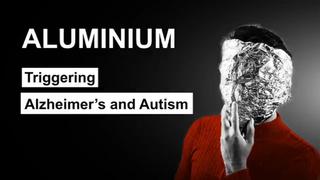James Lyons-Weiler: How aluminium leads to brain injury
By Rhoda Wilson on October 2, 2023
Aluminium is the most abundant metallic element in Earth’s crust. Because of its chemical activity, aluminium never occurs in the metallic form in nature, but its compounds are present to a greater or lesser extent in almost all rocks, vegetation, and animals.
It is commonly used as an adjuvant in vaccines. Aluminium that has been injected is linked to the onset of autoimmune diseases. It has also been linked to proteins found in the brains of people with Alzheimer’s disease. Below James Lyons-Weiler explains how aluminium is neurotoxic; it induces neurons to commit suicide.
“The evidence is clear. Here is a small sample of the damning literature. We must now help the public avoid this threat to public health,” he says.
By James Lyons-Weiler
Aluminium is a ubiquitous element found in the Earth’s crust, where it was bound to silica for nearly all of the 3.8 billion years of organic evolution on this planet.
Since the late 1800s, it has found its way into various aspects of human life, from cookware to vaccines. While it is generally considered safe for most applications, it is not: emerging evidence shows that it has neurotoxic effects, particularly in the context of neurodegenerative diseases like Alzheimer’s. Here we explore the mechanisms through which aluminium exposure leads to brain injury.
Mechanisms of Aluminium Neurotoxicity
Oxidative Stress
Aluminium has been identified as a neurotoxic agent that results in oxidative damage to cellular biomarkers. Oxidative stress is a well-known factor in the pathogenesis of neurodegenerative diseases, and aluminium’s role in exacerbating this cannot be ignored.
“Aluminium is an environmentally abundant potential neurotoxic agent that may result in oxidative damage to a range of cellular biomarkers.” (REVIEW)
Neuronal Apoptosis
[Neuronal apoptosis is an intrinsic suicide program by which a neuron orchestrates its own destruction.]
Aluminium has been shown to induce neuronal apoptosis both in vivo and in vitro. Apoptosis, or programmed cell death, is a critical mechanism in the development of neurodegenerative diseases.
“Aluminium induces neuronal apoptosis in vivo as well as in vitro, either by endoplasmic stress from the unfolded protein response, by mitochondrial dysfunction, or a combination of them.” (REVIEW with 167 citations therein)
Tau Protein and Amyloid-beta Accumulation
Aluminium exposure has been linked to the accumulation of tau protein and Amyloid-beta (Aβ) in the brain, both of which are hallmark features of Alzheimer’s disease.
Continued at link....


